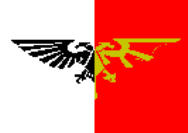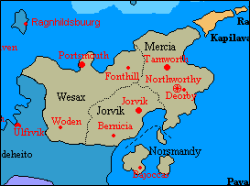Anglo-Saxon Commonwealth: Difference between revisions
No edit summary |
No edit summary |
||
| Line 24: | Line 24: | ||
The micronation was originally founded on the southern shores of the continent of [[Apollonia]] as the Duchy of Northworthy with a more generalised Western European theme in which Beckford was Duke, but after he discovered Cranda, Beckford merged the two nations together to become the new nation of Arminy. It was after this political change that the [[MCS]] moved Northworthy's territories to the far north-east of Apollonia to be near other territories of Arminy, where it remained until its death. After a brief period of rule by [[Stormark]], the gradual change towards a Saxon culture culminated in the independence of the Anglo-Saxon Commonwealth, which many continued to call Northworthy and which was active until early 2005. | The micronation was originally founded on the southern shores of the continent of [[Apollonia]] as the Duchy of Northworthy with a more generalised Western European theme in which Beckford was Duke, but after he discovered Cranda, Beckford merged the two nations together to become the new nation of Arminy. It was after this political change that the [[MCS]] moved Northworthy's territories to the far north-east of Apollonia to be near other territories of Arminy, where it remained until its death. After a brief period of rule by [[Stormark]], the gradual change towards a Saxon culture culminated in the independence of the Anglo-Saxon Commonwealth, which many continued to call Northworthy and which was active until early 2005. | ||
The constitutent territories of the Commmonwealth were Jorvik, | The constitutent territories of the Commmonwealth were [[Jorvik]], [[Norsmandy]], Danelaw, Anglien, Westhumbria, Wessax and Mercia. The internal borders of the nation changed regularly due to conflict between the constituent Kingdoms of the Commonwealth which in many respects went a long way towards providing the historical simulation of Anglo-Saxon politics which was initially intended. | ||
This historical simulationism could also be seen in the ethnic makeup of the nation, in which two main ethnic groups are referred to as being the Hum (a North Germanic people named after the micronation of [[Hurmu]]) and the Whealsh, a people of presumably Celtic extraction but with a vague historical link to the nation of [[Karnali]]. Saxon culture was also simulated with the main legislative body of the Commonwealth known as the Witan, with the Head of State being the High Priest at Odhingart and Head of Government being the Over King of Northworthy. | This historical simulationism could also be seen in the ethnic makeup of the nation, in which two main ethnic groups are referred to as being the Hum (a North Germanic people named after the micronation of [[Hurmu]]) and the Whealsh, a people of presumably Celtic extraction but with a vague historical link to the nation of [[Karnali]]. Saxon culture was also simulated with the main legislative body of the Commonwealth known as the Witan, with the Head of State being the High Priest at Odhingart and Head of Government being the Over King of Northworthy. | ||
[[Category:Dead Nations]][[Category:Nations]] | [[Category:Dead Nations]][[Category:Nations]] | ||
Latest revision as of 20:46, 13 February 2022
The Anglo-Saxon Commonwealth (also known unofficially as the Kingdom of Northworthy and Angsax) was an Anglo-Saxon themed micronation with a highly developed federated political structure based on the Anglo-Saxon Kingdoms of Britain. The micronation was originally founded on the southern shores of the continent of Apollonia as the Duchy of Northworthy with a more generalised Western European theme in which Beckford was Duke, but after he discovered Cranda, Beckford merged the two nations together to become the new nation of Arminy. It was after this political change that the MCS moved Northworthy's territories to the far north-east of Apollonia to be near other territories of Arminy, where it remained until its death. After a brief period of rule by Stormark, the gradual change towards a Saxon culture culminated in the independence of the Anglo-Saxon Commonwealth, which many continued to call Northworthy and which was active until early 2005.
The constitutent territories of the Commmonwealth were Jorvik, Norsmandy, Danelaw, Anglien, Westhumbria, Wessax and Mercia. The internal borders of the nation changed regularly due to conflict between the constituent Kingdoms of the Commonwealth which in many respects went a long way towards providing the historical simulation of Anglo-Saxon politics which was initially intended. This historical simulationism could also be seen in the ethnic makeup of the nation, in which two main ethnic groups are referred to as being the Hum (a North Germanic people named after the micronation of Hurmu) and the Whealsh, a people of presumably Celtic extraction but with a vague historical link to the nation of Karnali. Saxon culture was also simulated with the main legislative body of the Commonwealth known as the Witan, with the Head of State being the High Priest at Odhingart and Head of Government being the Over King of Northworthy.

